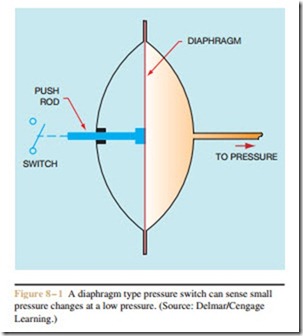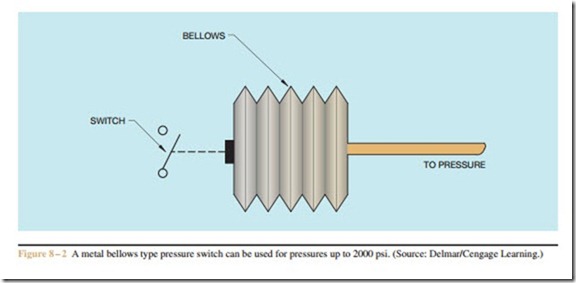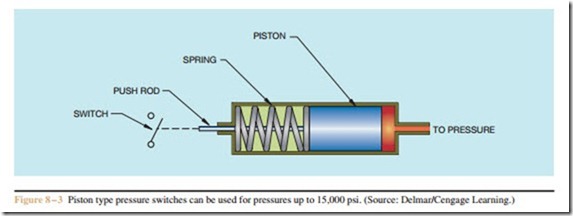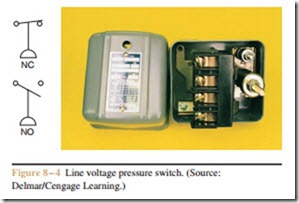Pressure Switches
Pressure switches are found throughout industry in applications where it is necessary to sense the pressure of pneumatic or hydraulic systems. Pressure switches are available that can sense pressure changes of less than 1 psi (pound per square inch) or pressures over 15,000 psi. A diaphragm operated switch can sense small pressure changes at low pressure (Figure 8 – 1).
A metal bellows type switch can sense pressures up to 2000 psi. The metal bellows type pressure switch employs a metal bellows that expands with pressure (Figure 8 – 2). Although this switch can be used to sense a much higher pressure than the diaphragm type, it is not as sensitive in that it takes a greater change in pressure to cause the bellows to expand enough to active a switch. A piston type pressure switch can be used for pressures up to 15,000 psi (Figure 8 – 3).
Regardless of the method used to sense pressure, all pressure switches activate a set of contacts. The contacts may be either single pole or double pole depending on the application, and will be designed with some type of snap-action mechanism. Contacts cannot be permitted to slowly close or open. This would pro- duce a bad connection and cause burning of the contacts as well as low voltage problems to the equipment they control. Some pressure switches are equipped with contacts large enough to connect a motor directly to the power line, and others are intended to control the operation of a relay coil. A line voltage type pressure switch is shown in Figure 8 – 4. Pressure switches of this type are often used to control the operation of well pumps and air compressors (Figure 8 – 5).
about 30 psi and cut out at about 50 psi. The 20 pounds of differential pressure is necessary to prevent over- working the pump motor. Without differential pres- sure, the pump motor would continually turn on and off. This is what happens when a tank becomes water- logged. An air space must be maintained in the tank to permit the pressure switch to function. The air space is necessary because air can be compressed, but a liquid cannot. If the tank becomes waterlogged, the pressure switch would turn on and off immediately each time a very small amount of water was removed from the tank. Pressure switch symbols are shown in Figure 8 – 6.
Differential Pressure
Differential pressure is the difference in pressure between the cut-in or turn-on pressure and the cut-out or turn-off pressure. Most pressure switches provide a means for setting the pressure differential. In the ex- ample shown in Figure 8 – 5, a line voltage pressure switch controls the motor of a well pump. Typically, a pressure switch of this type would be set to cut in at
Typical Application
Pressure switches are used in many common in- dustrial applications. A circuit that is used to turn off a motor and turn on a pilot warning light is shown in Figure 8 – 7. In this circuit, a pressure switch is connected to a control relay. If the pressure should become too great, the control relay will open a normally closed contact connected to a motor starter to stop the motor. A normally open PSCR (pressure switch control relay) contact will close and turn on a pilot light to indicate a high pressure condition. Notice that in this example circuit, the pressure switch needs both normally open and normally closed contacts. This is not a common contact arrangement for a pressure switch. To solve the problem, the pressure switch controls the action of a control relay. This is a very common practice in industrial control systems.



